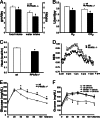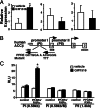PPARdelta regulates glucose metabolism and insulin sensitivity
- PMID: 16492734
- PMCID: PMC1413918
- DOI: 10.1073/pnas.0511253103
PPARdelta regulates glucose metabolism and insulin sensitivity
Abstract
The metabolic syndrome is a collection of obesity-related disorders. The peroxisome proliferator-activated receptors (PPARs) regulate transcription in response to fatty acids and, as such, are potential therapeutic targets for these diseases. We show that PPARdelta (NR1C2) knockout mice are metabolically less active and glucose-intolerant, whereas receptor activation in db/db mice improves insulin sensitivity. Euglycemic-hyperinsulinemic-clamp experiments further demonstrate that a PPARdelta-specific agonist suppresses hepatic glucose output, increases glucose disposal, and inhibits free fatty acid release from adipocytes. Unexpectedly, gene array and functional analyses suggest that PPARdelta ameliorates hyperglycemia by increasing glucose flux through the pentose phosphate pathway and enhancing fatty acid synthesis. Coupling increased hepatic carbohydrate catabolism with its ability to promote beta-oxidation in muscle allows PPARdelta to regulate metabolic homeostasis and enhance insulin action by complementary effects in distinct tissues. The combined hepatic and peripheral actions of PPARdelta suggest new therapeutic approaches to treat type II diabetes.
Conflict of interest statement
Conflict of interest statement: No conflicts declared.
Figures




Similar articles
-
PPARdelta is a fatty acid sensor that enhances mitochondrial oxidation in insulin-secreting cells and protects against fatty acid-induced dysfunction.J Lipid Res. 2010 Jun;51(6):1370-9. doi: 10.1194/jlr.M001123. Epub 2009 Nov 30. J Lipid Res. 2010. PMID: 19965574 Free PMC article.
-
Improved insulin sensitivity and islet function after PPARdelta activation in diabetic db/db mice.Eur J Pharmacol. 2010 Jan 25;626(2-3):297-305. doi: 10.1016/j.ejphar.2009.09.053. Epub 2009 Oct 8. Eur J Pharmacol. 2010. PMID: 19818749
-
CD36-dependent regulation of muscle FoxO1 and PDK4 in the PPAR delta/beta-mediated adaptation to metabolic stress.J Biol Chem. 2008 May 23;283(21):14317-26. doi: 10.1074/jbc.M706478200. Epub 2008 Feb 28. J Biol Chem. 2008. PMID: 18308721 Free PMC article.
-
Novel approach to treat insulin resistance, type 2 diabetes, and the metabolic syndrome: simultaneous activation of PPARalpha, PPARgamma, and PPARdelta.Curr Diabetes Rev. 2005 Aug;1(3):299-307. doi: 10.2174/157339905774574365. Curr Diabetes Rev. 2005. PMID: 18220606 Review.
-
Roles of peroxisome proliferator-activated receptor delta (PPARdelta) in the control of fatty acid catabolism. A new target for the treatment of metabolic syndrome.Biochimie. 2004 Nov;86(11):833-7. doi: 10.1016/j.biochi.2004.09.024. Biochimie. 2004. PMID: 15589693 Review.
Cited by
-
Nrf2 modulates the benefits of evening exercise in type 2 diabetes.Sports Med Health Sci. 2023 Sep 9;5(4):251-258. doi: 10.1016/j.smhs.2023.09.001. eCollection 2023 Dec. Sports Med Health Sci. 2023. PMID: 38314046 Free PMC article. Review.
-
Metabolic Biomarkers in Adults with Type 2 Diabetes: The Role of PPAR-γ2 and PPAR-β/δ Polymorphisms.Biomolecules. 2023 Dec 14;13(12):1791. doi: 10.3390/biom13121791. Biomolecules. 2023. PMID: 38136661 Free PMC article.
-
Peroxisome Proliferator-Activated Receptors and Their Novel Ligands as Candidates for the Treatment of Non-Alcoholic Fatty Liver Disease.Cells. 2020 Jul 8;9(7):1638. doi: 10.3390/cells9071638. Cells. 2020. PMID: 32650421 Free PMC article. Review.
-
Adipose tissue signaling by nuclear receptors in metabolic complications of obesity.Adipocyte. 2012;1(1):4-12. doi: 10.4161/adip.19036. Adipocyte. 2012. PMID: 22916336 Free PMC article.
-
Expression profiling of peroxisome proliferator-activated receptor-delta (PPAR-delta) in mouse tissues using tissue microarray.Histochem Cell Biol. 2007 May;127(5):485-94. doi: 10.1007/s00418-007-0279-5. Epub 2007 Mar 2. Histochem Cell Biol. 2007. PMID: 17333240
References
Publication types
MeSH terms
Substances
Grants and funding
LinkOut - more resources
Full Text Sources
Other Literature Sources
Medical
Molecular Biology Databases
Miscellaneous

